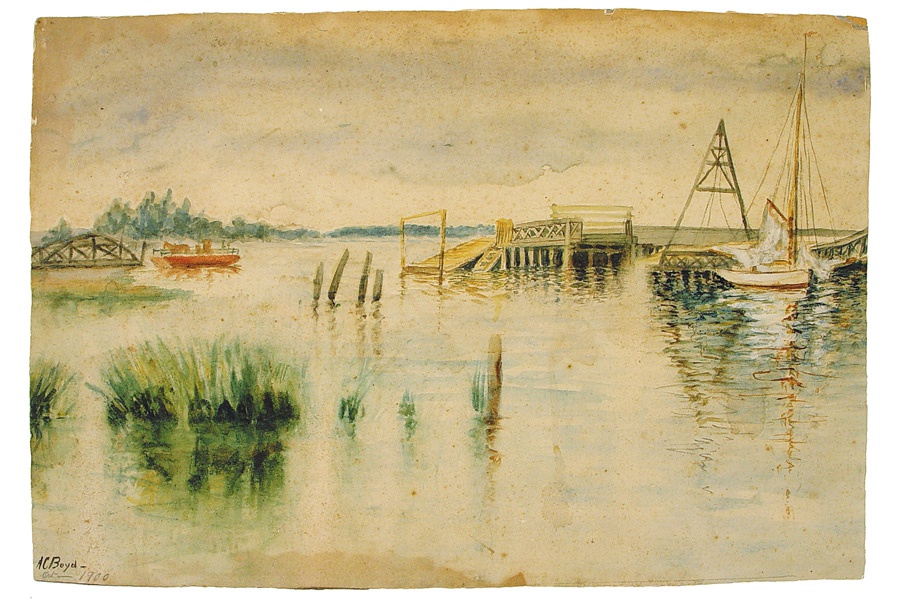Historic Annie Cooper Boyd Paintings Displayed in Sag Harbor

The Sag Harbor Historical Society is kicking off every other summer weekend with “Fridays on the Porch,” an informal gathering with wine and cheese refreshments at their historic Annie Cooper Boyd House headquarters at 174 Main Street. Stop by from 5:30–6 p.m. this Friday, July 12 and take advantage of this free open house event (though donations are always appreciated).
The Annie Cooper Boyd House dates back to the 18th century and it has several works of art on display by its namesake, who moved there in the 1870s. This week, Rebecca Radin, a docent at the Parrish Art Museum, will lead an informal program on William Merritt Chase‘s Shinnecock art school, which Annie Cooper Boyd (1864-1941) attended in the 1890s.
Included below, and in the featured image above, are pictures of, and facts about, Cooper Boyd’s paintings at the house, graciously supplied by the Sag Harbor Historical Society. Along with each being a fascinating window into East End history, the pieces are beautiful art objects and examples of landscape painting from the day.
Read about Boyd’s painting of the 1900 Collapse of the North Haven Bridge (pictured above), then scroll down to learn about her other works.
“North Haven Bridge Collapse”
Annie documented the 1900 collapse of the North Haven Bridge, which was financed and built by watch case and silverware tycoon Joseph Fahys just nine years earlier in 1881. After the collapse, a ferry service captained by George Page was put into operation. Sag Harbor, The Story of an American Beauty. chronicles the event, noting, “The resounding crash of this bridge was heard throughout the village in 1900.”

“Sandpiper Hill”
Sandpiper Hill house was built in 1928 by architect Richard Webb for Walter McCaffray and his wife when McCaffray was riding high, holding 12 seats on the New York Stock Exchange. While attractive to behold, the windmill was far from a functional. Inside, eight walls of hand-blown pink-glass mirrors covered the powder room on the ground floor, while the top floor was filled with books reflecting the McCaffrays’ deep interest in Montauk history. It was Sandpiper Hill where Teddy Roosevelt and regiments camped after returning from Cuba at the end Spanish American War in 1898.
Outside, at McCaffray’s eastern and western lot lines stood a wooden Indian and a wooden statue of Captain Kidd gazing in the direction of his buried treasure on Gardiners Island. Rumor has it that kids burned down the three statues, and following the stock market crash of 1929, Walter McCaffray committed suicide. Another rumor suggests he jumped to his death.
The McCaffrays were founders of St. Thérèse of Lisieux, Montauk’s Catholic church, where Edgar Grimes was employed. During the 1930s Edgar and Cecilia Grimes moved in and became caretakers for Sandpiper Hill. Cecilia was there when the windows blew out in the hurricane of 1938—she and the children took refuge in the garage as storm waters isolated them from Edgar and other children caught in town. Next, the Sandpiper Hill estate was donated to the Jesuits. They, in turn, sold it to another stockbroker, Sidney Rheinstein, who leased it to summer vacationers.

“Frank C. Havens’ Summer Cottage” (Now Cormaria)
Cormaria, built by Frank C. Havens in 1905, is Sag Harbor’s grandest building to survive the village’s fiery history. In 1864, it was actually the burning down of the village’s finest center of learning, the Sag Harbor Academy and Institute—along with its valuable library of 1,000 books—that sparked Havens’ illustrious career. He was descended from a respected line of local Havens, beginning with one of the earliest settlers of Shelter Island in 1700, but it was Havens who set the fire. Shamed by his actions, he was sent off to California by his father, Captain Wickham Havens.
Over the next 35 years in California, Havens shrewdly invested in real estate, becoming a wealthy financier while also gathering around himself leaders in all the arts, including another Sag Harbor boy, his nephew George Sterling, who was informally dubbed the poet laureate of San Francisco. Havens returned to Sag Harbor for the summer of 1899, not to resurrect the Academy, but to add to his real estate empire and plan a grand “summer cottage” for himself and family. That year he purchased large pieces of waterfront property on the East Hampton side of the village including land at Conkling’s Point, where he would build his summer estate. He even found time to host a burlesque dance and cake walk at the Hannibal French house.
Havens, his wife Lila and four children enjoyed summers in his elegant summer estate fitted with hot and cold water, gas and electric, and his private fire hydrant all set on beautifully landscaped bay front acres. He is best remembered for showing off the most beautiful “painting” in the world as he drew the drapes from the 14-foot-wide dining room window to reveal his view of Shelter Island Bay.
Havens’ recklessness finally led to failure of his investments, so he protected the remainder of his real estate by putting it in Lila’s name. He died several years later in 1918, the year after Cooper Boyd painted this picture.
(CONTINUED ON PAGE 2)

“Napeague Dune”
Annie Cooper Boyd painted this Napeague dune in 1933. It is one of two paintings of the same scene, which are exhibited side by side at the Sag Harbor Historical Society for the viewer to note note the subtle differences. A trip to Napeague today will show that little has changed in this pristine location over the past eighty years.
The Sag Harbor Historical Society welcomes the public to drop by for Fridays on the Porch at 5:30 p.m. on July 12, July 26, August 9 and August 23.
Visit sagharborhistoricalsociety.org to learn more.



